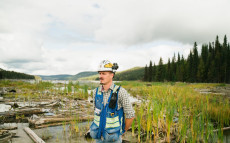- pathfindersAI
- Job Profile
Fire-Prevention and Protection Engineers
Summary
Fire-Prevention and Protection Engineers: A Career Guide
What They Do
Fire-Prevention and Protection Engineers are specialized professionals dedicated to ensuring the safety of buildings, structures, and communities from the threat of fire. Their expertise lies in understanding fire dynamics, risk assessment, and the implementation of preventive measures. These engineers play a crucial role in the design of fire alarm and suppression systems, evacuation planning, and ensuring compliance with fire safety regulations. Fundamentally, they work to minimize risks and enhance safety in various environments, including residential buildings, commercial enterprises, industrial facilities, and public spaces.
Job Responsibilities
The primary responsibilities of Fire-Prevention and Protection Engineers revolve around the development and implementation of fire safety protocols. They conduct hazard assessments to identify potential fire risks and develop comprehensive mitigation strategies. These engineers are actively involved in the design of fire safety systems, which include alarm systems, sprinkler systems, and fire suppression systems. Additionally, they create evacuation plans and conduct drills to prepare occupants for emergency situations. Ensuring that all fire safety measures comply with local, state, and federal regulations is another critical responsibility. Moreover, they often collaborate with architects, construction teams, and government officials to integrate fire safety into new and existing buildings.
Essential Skills
Success in the field of fire-prevention and protection engineering requires a diverse set of skills. Strong analytical and problem-solving abilities are essential for assessing risks and developing effective safety measures. Engineers must have an in-depth understanding of fire dynamics and behavior, as well as knowledge of fire safety standards, codes, and regulations. Proficiency in using computer-aided design (CAD) software and fire modeling tools is also crucial. Effective communication skills are vital, enabling engineers to convey complex information to diverse stakeholders, including building owners, construction teams, and regulatory agencies. Additionally, a detail-oriented mindset and the ability to work under pressure are invaluable traits for ensuring thorough and timely completion of safety assessments and implementations.
Educational Pathways
Aspiring Fire-Prevention and Protection Engineers typically begin their journey with a Bachelor’s degree in Fire Protection Engineering, Fire Science, or a related field. Undergraduate coursework often includes subjects such as fire dynamics, risk analysis, fire detection and suppression systems, and building codes. To enhance their expertise, many professionals pursue advanced degrees or specialized certifications. A Master’s degree in Fire Protection Engineering or a related discipline can provide deeper knowledge and open up higher-level career opportunities. Additionally, certifications from recognized bodies, such as the National Institute for Certification in Engineering Technologies (NICET) or the Society of Fire Protection Engineers (SFPE), can significantly bolster one’s credentials and professional standing.
Career Prospects
The demand for Fire-Prevention and Protection Engineers continues to grow, driven by increased awareness of fire safety and stringent regulatory requirements. Career opportunities span various industries, including construction, manufacturing, insurance, and government agencies. Engineers often find employment with architectural firms, engineering consultancies, fire equipment manufacturers, and safety regulatory bodies. As the field continues to evolve, there is a growing need for professionals with advanced expertise in areas such as sustainable fire protection solutions, advanced fire modeling, and high-tech fire detection systems. According to industry trends, the career outlook for Fire-Prevention and Protection Engineers remains robust, with opportunities for advancement into roles such as senior engineer, project manager, or fire safety consultant.
Conclusion
Fire-Prevention and Protection Engineers play an indispensable role in safeguarding lives and property from the devastating effects of fire. With their specialized knowledge and unwavering commitment to safety, they serve as the frontline defenders in the ongoing battle against fire hazards. For those passionate about making a tangible impact on public safety and equipped with the necessary skills and education, a career in fire-prevention and protection engineering offers both fulfillment and professional growth. The journey is challenging, but the reward lies in the ability to design safer environments and protect communities, making it an exemplary vocation for dedicated engineers.
Video
Compensation
| State | Median Salary | Median Hourly | Positions |
|---|---|---|---|
| AL | 104,610 | 50.29 | 610 |
| AK | 119,100 | 57.26 | 100 |
| AZ | 112,250 | 53.97 | 170 |
| AR | 82,830 | 39.82 | 200 |
| CA | 127,990 | 61.54 | 2,230 |
| CO | 107,210 | 51.54 | 250 |
| CT | 113,170 | 54.41 | 110 |
| DE | 104,960 | 50.46 | 70 |
| DC | 126,820 | 60.97 | 160 |
| FL | 94,310 | 45.34 | 1,320 |
| GA | 99,750 | 47.96 | 620 |
| HI | 97,140 | 46.70 | 40 |
| ID | 96,630 | 46.46 | 90 |
| IL | 92,680 | 44.56 | 220 |
| IN | 93,180 | 44.80 | 340 |
| IA | 102,050 | 49.06 | 140 |
| KS | 109,220 | 52.51 | 100 |
| KY | 88,390 | 42.50 | 560 |
| LA | 122,220 | 58.76 | 280 |
| ME | 85,440 | 41.08 | 70 |
| MD | 105,020 | 50.49 | 600 |
| MA | 114,170 | 54.89 | 710 |
| MI | 102,130 | 49.10 | 870 |
| MN | 123,250 | 59.25 | 420 |
| MS | 82,540 | 39.68 | 160 |
| MO | * | * | 290 |
| MT | 78,630 | 37.80 | 80 |
| NE | 96,340 | 46.32 | 180 |
| NV | * | * | 170 |
| NJ | 108,940 | 52.38 | 840 |
| NM | 105,150 | 50.55 | 270 |
| NY | 105,630 | 50.78 | 1,540 |
| NC | 116,310 | 55.92 | 290 |
| OH | 103,020 | 49.53 | 460 |
| OK | 104,580 | 50.28 | 650 |
| OR | 117,050 | 56.27 | 150 |
| PA | 99,770 | 47.97 | 980 |
| RI | 92,680 | 44.56 | 40 |
| SC | 73,040 | 35.11 | 510 |
| TN | 111,990 | 53.84 | 420 |
| TX | 110,790 | 53.26 | 2,910 |
| UT | 98,420 | 47.32 | 280 |
| VA | 99,220 | 47.70 | 380 |
| WA | 107,900 | 51.88 | 600 |
| WV | 82,980 | 39.89 | 320 |
| WI | 82,560 | 39.69 | 550 |
Similar Occupations
In this area you will find other occupations that are close to the one you were viewing in tasks, knowledge and work environment. If the primary job profile you are viewing isn't quite to your liking, take a look around and see what else is available.
Basic and Premium Accounts have more alternative occupations available than the Free account.

Construction and Building Inspectors - 47-4011.00
Construction and Building Inspectors evaluate the structural integrity and compliance of buildings and construction projects with local codes, ordinances, and regulations. They conduct detailed inspections to ensure safety standards are met and provide reports to document their findings and necessary corrective actions.
-
$67,700/yr
Median Pay -
133,640
Number of Jobs

Environmental Engineers - 17-2081.00
Environmental engineers develop solutions to environmental problems by designing systems and processes that promote sustainable development and protect human health and the environment. They work on projects ranging from pollution control and waste management to water and air quality improvement.
-
$100,090/yr
Median Pay -
39,880
Number of Jobs